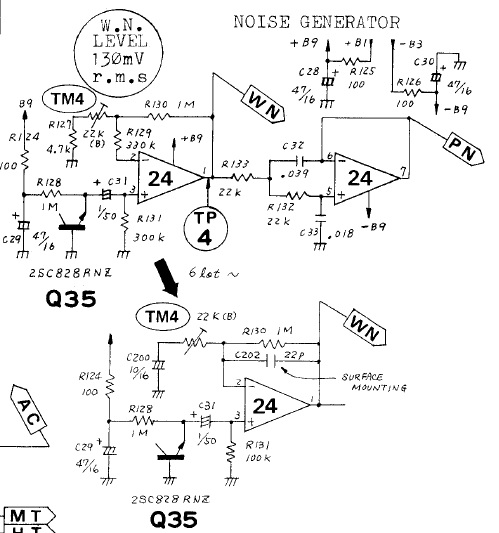Ahh, there's nothing like the feeling you get when using an original piece of gear. Unless you know for sure what the circuit is really doing, there will always be doubt about a clone of some circuit. I made a Neve pre but I don't REALLY know if it's right because I have never studied an original.
So is this the circuit with he 2SC828?
Everything around the emitter junction is high impedance at all frequencies so even if the emitter junction has some weird impedance variations, they wouldn't be in the OA output.
I would think this should be just white noise. It even says in the circle "W. N. LEVEL 130mV r.m.s" which suggests white noise level 130 mV RMS which is 368 mVpp. Gain of the OA is ~70-100 depending on which of the two circuit variations is being used but that means 368 / 70 = 5 mVpp output from this infamous transistor. This actually seems low to me but I've never actually played around with a circuit like this so maybe someone else can comment on that.
Whatever the noise output of that circuit is, it can almost definitely be exactly replicated. It's just noise that needs to be boosted anyway so if it's missing lows or has a little mid boost, that can easily be tweeked.
If you have access to an original TR-808, make a probe with a 150 resistor to the op amp output (TP4) on the end of a short well shielded cable w/ shield to ground of device and then directly into a high res digital audio interface. Do NOT turn on 48V or you will destroy the op amp! Record 10 seconds of the noise output. That recording can be analyzed in Matlab or Octave to produce high res frequency spectra.
Note: Generally, if you're not well experienced with electronics repair, I do not recommend opening a valuable original instrument like a TR-808 because you can cause harm. For example, even small amounts of static electricity discharged into digital IOs (yes, there is some old school digital bits in there) can destroy their gates. I saw a video of someone working on a Yamaha CS60 and they destroyed a bunch of chips poking around (mostly because the chassis is wood but plastic isn't any better!). So make sure everything is grounded and you're not wearing a fleece vest and don't haphazardly poke around at things.
Note that it would not surprise me at all of original units sounded different from clones because, judging from a cursory look at the circuit, any electrolytics used as filters would dry out after 30 years and loose their filtering abilities.



